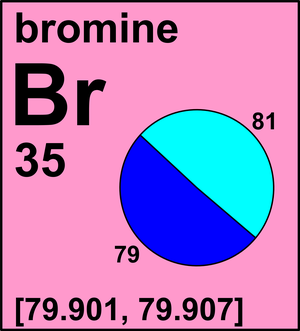Bromine
| Isotope | Atomic mass (Da) | Isotopic abundance (amount fraction) |
|---|---|---|
| 79Br | 78.918 338(7) | [0.505, 0.508] |
| 81Br | 80.916 288(6) | [0.492, 0.495] |
In 1961, the Commission recommended Ar(Br) = 79.909(2) based on a chemical determination of the mass ratio AgBr/Ag and an updated evaluation of the atomic weight of silver, which was then the major source of the uncertainty in Ar(Br). The values of Ar(Br) and Ar(Ag) were especially important at that time because the atomic weights of many other elements were determined by the mass ratios of their bromides to Ag or AgBr. In its 1965 re-evaluation, summarized in the 1967 report, the Commission adopted the recent mass-spectrometric measurements, which yielded Ar(Br) = 79.904(1) and essentially ended the era of chemical determinations of atomic weights for this element.
The standard atomic weight of bromine was last revised in 2011 to better reflect the natural variations of Ar(Br) in natural materials.
Atomic weights of the elements 2011 by M.E. Wieser et al. Pure Appl. Chem. 2013 (85) 1047-1078

CIAAW
Bromine
Ar(Br) = [79.901, 79.907] since 2011
The name derives from the Greek bromos for "bad stench" or "bad odour". It was first prepared by the
German chemist Carl Löwig in 1825, but it was first publicly announced in 1826 by the French chemist
and pharmacist Antoine-Jérôme Balard, and so the discovery is, therefore, credited to him.
Natural variations of bromine isotopic composition
Isotopic reference materials of bromine.


